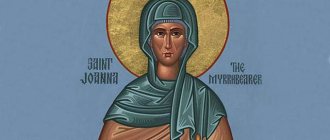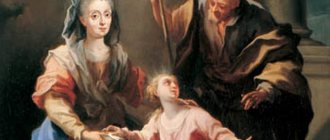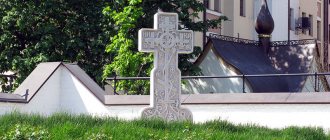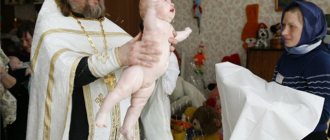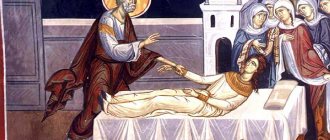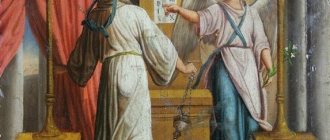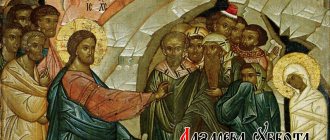Drawing described in the Gospel of John; sister of Lazarus and Martha, living in the village of Bethany near Jerusalem; traditionally identified with Mary Magdalene
| Saint Mary of Bethany | |
| Christ in the House of Martha and Mary , Johannes Vermeer, before 1654–1655, oil on canvas (National Gallery of Scotland, Edinburgh) - Mary sits at the feet of Jesus | |
| Mary the Righteous, sister of Lazarus; Myrrh-Bearer | |
| Revered in | Latin Christianity Eastern Catholicism Eastern Orthodoxy Eastern Orthodoxy Anglican Communion Lutheranism |
| Holiday | June 4 (Orthodox), July 29 (Catholic/Lutheran/Anglican) |
| Attributes | woman holding a jug of myrrh and a handkerchief |
Mary of Bethany
(Judeo-Aramaic מרים,
Maryam
, rendered αρία, Mary, in Koine Greek from the New Testament; Hebrew form מִרְיָם, Miriam, or Miriam, "desired child", "bitter" or "rebellious") - this biblical figure is mentioned by name only in the Gospel of John in the Christian New Testament. Together with her brothers and sisters Lazarus and Martha, according to John's description, she lived in the village of Bethany near Jerusalem.[1]
Medieval Western Christianity identified Mary of Bethany with Mary Magdalene and with the sinful woman of Luke 7:36–50. This influenced the Roman rite liturgy of the feast of Mary Magdalene, with the Gospel about the sinful woman and the collection referring to Mary of Bethany. Since the 1969 Revision of this liturgy, the feast of Mary Magdalene still falls on July 22, but Mary of Bethany is celebrated along with her brother Lazarus on July 29, a memorial for their sister Martha.[2] In Eastern Christianity and some Protestant tradition, Mary of Bethany and Mary Magdalene are considered separate people.[3] The Orthodox Church has its own traditions regarding the life of Mary of Bethany outside of the Gospel accounts.
St. Lazarus of four days and his sisters Martha and Mary
Excerpt from “The Life and Works of the Holy Glorious and All-Praised Twelve Apostles of the Lord, the Seventy Lesser Apostles and Other Equal-to-the-Apostles Evangelists of Christ”
Our Lord Jesus Christ, during His earthly life, did not spend time more calmly and happily anywhere than in Bethany, in the family of Martha and Mary and their brother Lazarus, as can be seen from the instructions of the Evangelist John the Theologian, who says: Jesus loved Martha and her sister and Lazarus (John 11:5). From the legends of St. Evangelists here is what we know about this pious family. Thus, the Evangelist Luke narrates that once the Lord was in Bethany and here a woman named Martha invited Him to her house. Martha’s sister, Mary, sat at the feet of Jesus and listened to His teachings. Meanwhile, Martha was trying to please the Lord better and, approaching Him, said: Lord, or don’t you need it, that my sister left me alone to serve! tell her to help me. Jesus answered and said to her: Martha! Marfa! you care and fuss about many things, but only one thing is needed; Mary chose the good part, which will not be taken away from her (Luke 10:38-40). In addition, the three Evangelists mention sister Mary in their Gospels, almost identically conveying the story of the anointing of Jesus Christ with precious myrrh at a supper in the house of Simon the leper, which was performed by Mary, the sister of the resurrected Lazarus. The Evangelists' story is stated as follows: Six days before Easter, on the eve of Christ's entry into Jerusalem for the free passion, when Christ was in Bethany at the supper prepared for Him, in the house of Simon the leper, and Lazarus, resurrected by Christ, shared a meal with Him, and Martha served Him, Mary Taking a vessel with precious ointment, she anointed Jesus’ feet with it, wiped them with her hair and poured ointment on His head. At the same time, Judas Iscariot expressed his opinion that it would be better to sell this ointment and give the proceeds to the poor; The Lord Jesus Christ objected to this: “Why are you embarrassing this woman? She did a good deed for Me, because you always have the poor with you and can do good to them whenever you want, but you don’t always have Me. She did what she could, pouring this myrrh onto My body, she prepared Me for burial. And behold, I tell you truly, that wherever the Gospel is preached, in the whole world, what she has done will be told” (Matthew 26:6–13; Mark 14:3–9; John 12:1– 8).
The faith of these sisters in Jesus Christ was so ardent and sincere that when their brother Lazarus fell ill, the first thing they did was notify Jesus Christ of his illness, trusting only in Him alone that He could give relief to their brother. When Jesus came to Bethany, it had already been four days since Lazarus lay in the tomb. Bethany lay not far from Jerusalem and many of the inhabitants of Jerusalem came to Martha and Mary to console them in their grief. When Martha heard that the Lord was already close to their village, she went to meet Him and said: “Lord! If You had been here, my brother would not have died!” “Your brother will rise again,” Jesus Christ told her. Martha answered: “I know that he will rise on the Resurrection, on the last day.” Jesus said to her: “I am the Resurrection and the Life; whoever believes in Me, if he dies, he will live. And everyone who lives and believes in Me will never die. Do you believe this? “So, Lord, I believe that You are the Christ, the Son of God, who came into the world,” said Martha and, leaving Jesus, went home, secretly called her sister and said: “The Teacher is here and is calling you.” Mary immediately went to meet the Lord, fell in tears at His feet and cried out: “Lord! If You had been here, my brother would not have died!” The Jews, who left the house with Mary to follow her, as they thought, to her brother's grave, began to weep as they looked at her. Then the Lord was grieved and disturbed in spirit. He asked, “Where did you put it?” They answer him: “Lord! Come and see." Seeing tears in Jesus' eyes, the Jews said: “Look how He loved Lazarus! Couldn’t He, who opened the eyes of the blind man, prevent this one from dying?” Meanwhile, Jesus, grieving internally, approaches the cave in which the dead man lay. The cave was filled with stones; Jesus commanded that it be taken away. Then Martha said: “Lord! He’s been in the coffin for four days now, and there’s a bad smell.” Jesus said to her: “If you believe, you will see the glory of God.” When the stone was taken away, Jesus looked up to heaven, saying: “Father! I thank You that You heard Me, I knew that You would always hear Me, but I said this for the people standing here, so that they would believe that You sent Me.” Having said this, He cried out in a loud voice: “Lazarus! Get out!” The deceased immediately left. He was wrapped in burial cloths, and his face was covered with a scarf. “Unbind him, let him go,” said the Lord (John 11:1-3, 17-44). In addition, the Evangelist mentions that the resurrected Lazarus was with Jesus Christ at a supper in the house of Simon the leper (John 12:1).
After the murder of St. Archdeacon Stephen, when the persecution of Jerusalem Christians began, St. Lazarus was expelled from Judea and put out to sea in a boat without oars. By God's Will, the boat sailed to Fr. Cyprus, where in the city of Kydonia St. Lazarus began to preach Christ as an apostle, and was a bishop in this city, ordained to this rank by the Apostle Barnabas. Living in Cyprus, St. Lazarus ardently desired to see the Most Holy Theotokos, whom he had not seen for a long time, and he himself was afraid to arrive in Jerusalem to meet with Her. The Most Holy Theotokos, realizing this desire of St. Lazarus, wrote a message to him, in which, consoling him, she commanded him to send a ship for Her, on which She could arrive on the island of Cyprus, and forbade him to come to Jerusalem for Her sake. After reading this message, St. Lazarus was very happy, and also surprised at such humility of the Most Holy Theotokos, and without any delay, he equipped and sent a ship for Her. The Most Holy Theotokos, together with the Apostle and Evangelist John and some other companions, set sail on this ship to the island of Cyprus. On the way, due to contrary winds, the Mother of God had to land at Mount Athos. After a short stay here, the Most Holy Theotokos arrived on Fr. Cyprus, where I met St. Lazarus, who grieved over Her long journey, told Him about Her stay on Mount Athos and presented gifts specially made for him with her own hands - an omophorion and armlets. After spending a short time in Cyprus, the Mother of God returned to Jerusalem.
After the stay of the Most Holy Theotokos, St. Lazarus spent four days as a bishop in Cyprus for about thirty years, preaching Christ and confirming the faith of the pagans he converted, in which his sisters Mary and Martha zealously helped him. Where, when and how did the saints end their lives? Lazarus's sister is unknown from church traditions, but St. four-day-old Lazarus rested in peace on Fr. Cyprus.
Under Emperor Leo the Philosopher (886–911), the relics of St. Lazarus of four days was transferred from Cyprus to Constantinople. Historians Kedrin and Zonara talk about this event.
Memory of St. Lazarus of the Four Days is celebrated by the Holy Church on October 17, when the transfer of his relics from Fr. Cyprus to Constantinople, and the memory of his sisters Martha and Mary is celebrated on the Week of the Myrrh-Bearing Women.
Recommendations
- See Gospel and Schiller Texts, Gertud, Iconography of Christian Art, Vol.
i , pp. 158–59, 1971 (English translation from German), Lund Humphries, London, ISBN 0853312702 - ^ a b Martyrology Romanum
(Libreria Editrice Vaticana 2001 ISBN 978-88-209-7210-3), pp. 383, 398 - Carol Ann Newsome, Sharon H. Ring, Jacqueline E. Lapsley (eds.), Women's Bible Commentary
, para. 532: "Although Eastern Orthodox scholars have never subscribed to this conflation of Mary Magdalene with Mary of Bethany and the unnamed sinner, Gregory the Great's interpretation has cemented Mary Magdalene's reputation as a repentant sinner throughout much of her interpretative history in the West" (Westminster John Knox Press, 2012, third edition, revised and updated, ISBN 978-0-664-23707-3) - ^ a b
Tenney, Merrill K. (1994).
"John". In Kenneth L. Barker and John Kohlenberger III (eds.). Zondervan NIV Bible Commentary
. Grand Rapids, MI: Zondervan Publishing. - Henry, Matthew (1706). A Complete Commentary on the Whole Bible
. - ^ a b
"Mary", Easton Bible Dictionary, 1897. - Discussed in Van Til, Kent A. Three Anointings and One Offering: The Sinner in Luke 7.36–50. Archived 2012-07-07 in Archive.today, Journal of Pentecostal Theology, Volume 15, Number 1, 2006, pp. 73–82 (10). However, the author of this article himself does not adhere to this point of view.
- Hersey, Kim. Two Debtors Archived 2006-09-01 on the Wayback Machine, Wesleyan Center for Applied Theology, Northwestern Nazarene University.
- Liefeld, Walter L. (1994). "Luke". In Kenneth L. Barker and John Kohlenberger III (eds.). Zondervan NIV Bible Commentary
. Grand Rapids, MI: Zondervan Publishing. - "Luke 17:11." Biblehub
. Retrieved December 9, 2022. - ^ a b c
Pope, H. (1910). Saint Mary Magdalene, in The Catholic Encyclopedia. New York: Robert Appleton Company. - mentioned in Jansen, Katherine Ludwig (2001). The Making of the Magdalene: Preaching and Popular Devotion in the Late Middle Ages
. Princeton University Press. ISBN 978-0-691-08987-4. - Rivera, John (April 18, 2003). "John Rivera," "Recovery of Mary Magdalene" in "Worldwide Religious News," Baltimore Sun
, April 18, 2003." Wwrn.org. Retrieved 2018-04-05. - Fahlbusch, Erwin; Bromiley, Geoffrey William, ed. (2003). Encyclopedia of Christianity
. Volume 3. Eerdmans. item 447. ISBN 9789004126541. - Flader, John (2010). Question Time: 150 Questions and Answers about the Catholic Faith
. Taylor Trade Publications. pp. 79–81. ISBN 978-1-58979594-5. - About the Myrrh-Bearing Saints, Women's Choir of the Myrrh-Bearing Saints, Blauvelt, NY
- Righteous Mary, sister of Lazarus, Orthodox Church in America.
- Mary and Martha, sisters of Lazarus, Greek Orthodox Archdiocese of America.
- July Church of England Wake, Oremus.com.
Troparion to the righteous Martha and Mary of Bithynia, tone 3
The God-loving sisters of Righteous Lazarus, / Martha and the most glorious Mary, / with the pure heart of Christ in your life, loved nature, / the myrrh-bearers of the rank, / and Him, I to the Son of God, fearlessly confessed to nature, / for this reason now in the abodes of the Heavenly Father / with Angels and You reign gloriously with all the saints./ Pray, He who was loved by nature,/ and we, sinners, may be established in the faith and love of Christ// and be granted the Kingdom of Heaven.
Translation: God-loving sisters of Righteous Lazarus, glorious Martha and Mary, with a pure heart you loved Christ in your life, having accepted the rank of myrrh-bearers and Him as the Son of God, you confessed without fear, therefore now in the abodes of the Heavenly Father you reign with glory with the Angels and saints . Pray to Whom you have loved, and for us sinners to be confirmed in faith and love for Christ and to be worthy of the Kingdom of Heaven.
Commemoration as a saint
In the Catholic Church, on July 29, Mary of Bethany is celebrated together with her brother Lazarus. memorial for their sister Martha.[2]
Also in the Calendar of Saints of the Lutheran Church, July 29 is the date of the commemoration of Mary (along with Martha and Lazarus), as is the Calendar of Saints of the Episcopal Church and Church of England (along with Martha).[19]
She is celebrated in the Eastern Orthodox and Byzantine Rite of the Eastern Catholic Church with Sister Martha on June 4, as well as on Myrrh-Bearing Sunday (Third Sunday of Easter). It also figures prominently in commemorations of Lazarus Saturday (the day before Palm Sunday).
Prayer to the righteous Martha and Mary of Bithynia
Oh, holy and all-praised disciples of Christ, God-loving Martha and Mary! Pray to the Sweetest Jesus, whom you have loved and who has loved you, Whom you have confessed by nature, Christ, the Son of God, that He may also grant us, sinners, remission of sins, in the right and unfeigned faith of yours. standing erect. Instill in our hearts the spirit of the fear of God, humble trust in God, patience and mercy towards our neighbors. Deliver us with your prayers from the temptations of life, troubles and misfortunes, yes, having lived here in a quiet and peaceful life, with immaculate thoughts and a pure heart, with the boldness of faith and hope, we will come to this Last Judgment and, having given a good answer to it, eternal joy in the Kingdom Let us be worthy of heaven. Amen.
